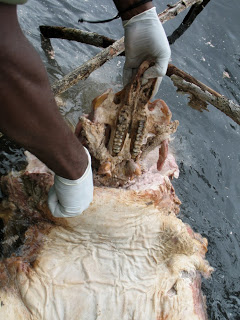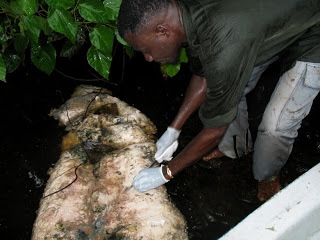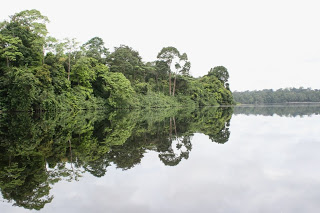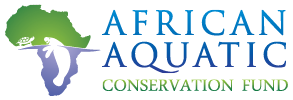What Happened at Lac Sounga?
A WWF boat was waiting for us at Sette Cama and DeDe and I set out first thing Tuesday morning. First we went next door to Sette Cama Safaris, where I stayed when I was here last year. Alain, the manager there, had found a manatee carcass last week. So we said hello to him & then got directions to the carcass, which was only a couple miles up the lagoon. It was very badly decomposed and many of the bones had already fallen out, but we were able to collect genetics samples and the skull.
 Next we turned in the other direction and headed north up the lagoon to Lac Sounga, a large lake near the lagoon’s mouth at the sea. This is where 3 manatee carcasses were reported in October by national park ecoguides working in the area, so we had GPS points of the locations. Just as we arrived there, a torrential rain started, and in seconds we were drenched. It was raining so hard we could barely see where we were going, but as soon as we reached the location of the first carcass, I saw it under some bushes. We pulled it out and it was even more badly decomposed than the first. Unfortunately it was impossible to tell if it was male or female, and although we searched for the pelvic bones (small bones that are uniquely shaped in males vs. females), we couldn’t find them. So again we collected tissue for genetics and the skull, including the ear bones, which are used to determine age in manatees. After that we headed back to the house, because there was almost no visibility and sitting in an open boat with the sensation of a giant faucet over your head starts to lose its novelty after a few hours.
Next we turned in the other direction and headed north up the lagoon to Lac Sounga, a large lake near the lagoon’s mouth at the sea. This is where 3 manatee carcasses were reported in October by national park ecoguides working in the area, so we had GPS points of the locations. Just as we arrived there, a torrential rain started, and in seconds we were drenched. It was raining so hard we could barely see where we were going, but as soon as we reached the location of the first carcass, I saw it under some bushes. We pulled it out and it was even more badly decomposed than the first. Unfortunately it was impossible to tell if it was male or female, and although we searched for the pelvic bones (small bones that are uniquely shaped in males vs. females), we couldn’t find them. So again we collected tissue for genetics and the skull, including the ear bones, which are used to determine age in manatees. After that we headed back to the house, because there was almost no visibility and sitting in an open boat with the sensation of a giant faucet over your head starts to lose its novelty after a few hours.
 Heading home with a bucket of skulls. If you stand in a cold shower with the aroma of rotting meat while viewing this photo, you’ll know exactly how I felt. But I’m not complaining- whenever I have field days like this, I remind myself that I could still be in a nice clean office selling dental malpractice insurance (one of my first jobs after college), but I would be bored out of my mind!
Heading home with a bucket of skulls. If you stand in a cold shower with the aroma of rotting meat while viewing this photo, you’ll know exactly how I felt. But I’m not complaining- whenever I have field days like this, I remind myself that I could still be in a nice clean office selling dental malpractice insurance (one of my first jobs after college), but I would be bored out of my mind! Wednesday was sunny and after Tuesday’s soaking we were glad. In the morning we went back to Lac Sounga (a 30 min. boat ride) to look for the remaining 2 carcasses and to survey the lake for live manatees. Sampling carcasses is important, but it’s much more fun to find live manatees! When we reached the two GPS locations for the remaining carcasses near the mouth, they weren’t there. The water has risen several feet since they were first reported, so by now they could be completely submerged in the coffee-dark water, or they could’ve floated away. So we started around the edge of the lake and about an hour later we came across a really badly decomposed carcass on the north shoreline. We sampled it for genetics and skull, started off again and about a minute later DeDe spotted another! We’ll never know if these are the same ones that were reported elsewhere in the lake, and suffice it to say they were literally giant bags of lard. The bad news is that for 4 carcasses I was unable to determine a cause of death (all organs were gone and most bones), and I couldn’t find pelvic bones on any of them, so I couldn’t determine much, other than they were adults. The good news is that we were able to collect 4 skulls, all with ear bones, and 8 genetic samples (I double sample every carcass because samples are so hard to come by for this species). There were no obvious signs of trauma (if they had been hunted or killed accidentally they wouldn’t have still been there) and since they were all in approximately the same state of decomposition, it’s likely they all died around the same time.
Wednesday was sunny and after Tuesday’s soaking we were glad. In the morning we went back to Lac Sounga (a 30 min. boat ride) to look for the remaining 2 carcasses and to survey the lake for live manatees. Sampling carcasses is important, but it’s much more fun to find live manatees! When we reached the two GPS locations for the remaining carcasses near the mouth, they weren’t there. The water has risen several feet since they were first reported, so by now they could be completely submerged in the coffee-dark water, or they could’ve floated away. So we started around the edge of the lake and about an hour later we came across a really badly decomposed carcass on the north shoreline. We sampled it for genetics and skull, started off again and about a minute later DeDe spotted another! We’ll never know if these are the same ones that were reported elsewhere in the lake, and suffice it to say they were literally giant bags of lard. The bad news is that for 4 carcasses I was unable to determine a cause of death (all organs were gone and most bones), and I couldn’t find pelvic bones on any of them, so I couldn’t determine much, other than they were adults. The good news is that we were able to collect 4 skulls, all with ear bones, and 8 genetic samples (I double sample every carcass because samples are so hard to come by for this species). There were no obvious signs of trauma (if they had been hunted or killed accidentally they wouldn’t have still been there) and since they were all in approximately the same state of decomposition, it’s likely they all died around the same time.
 After sampling the carcasses we moved along the rest of the lake edge and had 2 live manatee sightings, which was cool. The sightings were near places I saw manatees last year, but they swirled away through the dark water before I could get any photos (the story of my life in Gabon).
After sampling the carcasses we moved along the rest of the lake edge and had 2 live manatee sightings, which was cool. The sightings were near places I saw manatees last year, but they swirled away through the dark water before I could get any photos (the story of my life in Gabon).


No Comments